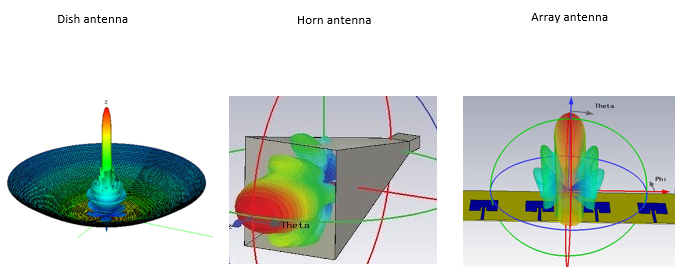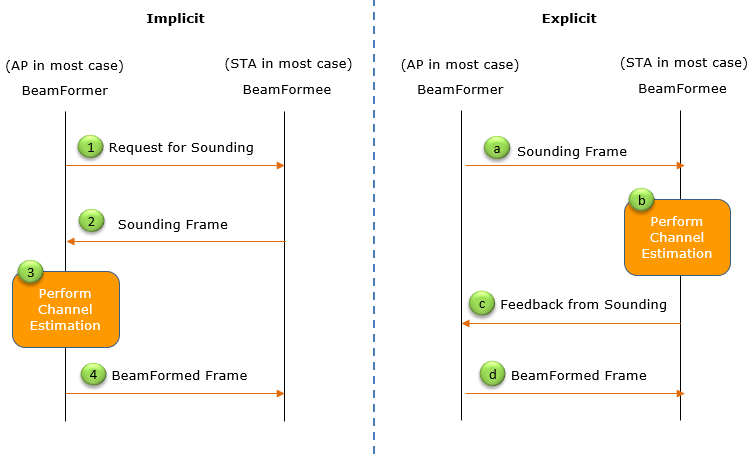|
|
||
|
BeamFormingBeamForming is a technology by which we can focus a antenna radiation pattern into a certain direction. In most of conventional wireless communication, the radiation pattern from the communication devices tend to be omnidirection meaning it radiate in all directions at similar energy strength, but there are some cases (especially in modern communication using high frequency) where we need to (or better to) focus the radiation to a certain direction rather than transmitting in all directions. Why beamforming ?I think there are two major reasons for beamforming. The first csae is where we want to do beamforming intentionally with a specific purpose and there is another case where we need to do beamforming even if we may not want to do. If a communication device is commuicating many other devices scattered all around, it would be better to use omidirectional antenna to cover all those devices. On the contrary, if a device is communicating with only one or a few devices in a certain direction it would be more efficient (less waste of energy) to form a beam to a certain direction where the communicating devices are located. In some other situation like very high frequencies are used, it is difficult to achieve enough distance coverage with single antenna (mostly omnidirectional). In this case, a common technology is to use multiple antenna to increase the coverage. Once we use multiple antenna (called Antenna) array to increase coverage, a specific shape of beam is formed due to the array type of positioning of the antenna elements. With this kind of array antenna, it is difficult to create omnidirectional radiation pattern even if we want... so beamforming would be the unavoidable solution. Whatever the motivation is, there are pros and cons for BeamForming. The advantage is that we can focus the radiation energy only to a necessary directions resulting in less waste of energy and the disadvantage is that it would require very complicated algorithm that can able to find the right direction where the reciever device is located and this sometimes gets really complicated when the reciever changes its position frequently (like celluar communication or some WiFi application). How to form a beam ?How to form a beam ? That is, how to shape the radiation pattern in such a way to point it to a certain direction ? There can be many ways to do it and some of the most widely used method, as far as I know, are illustrated as below. Most common way would be to use Dish or Horn antenna, but it would be impractical to use this kind of antenna for a small WiFi hotspot or mobile devices. Another issue with Dish antenna or horn antenna is that it is difficult to change the direction of the beam. To change the direction of the beam from Dish antenna or Horn antenna is to change the direction of the antenna mannualy or put some motors and change the direction using the motors (like Startlink dish antenna). So for the small devices or for the application where it needs to change the beam direction very frequently, they use array antenna (multiples of antenna arranged in the form of an array). Each of the antenna elements in the array can be a patch antenna as shown below or dipole antenna. Another advantage of array antenna is that it can change the beam direction electronically. Since the beamforming with using array antenna is so widely used in high end communication system like WiFi, Cellular System. I have written a note with much more details on beamforming. See this note if you are interested in the details of beamforming.
How to perform BeamForming in WiFi protcol ?Now we know what is the beamforming and why we want to use the technique. Then a question arises. How the transmitter (BeamFormer) wants to know which direction it should point the beam to ? If the location of the transmitter and reciever is fixed, the determining the beam direction would be simple. You just point the antenna of transmitter and reciever in such a way that they are aligned in line of sight at the time of installation (Most of satellite communication or microwave link determine the beam direction in this way). However, in case of WiFi the position of AP and Station, especially the position of Stations changes very frequently. So a working beam direction now would not work in a few minutes later. It mean that there should be some mechanism by which the BeamFormer figure out the proper direction of the beam dynamically. This kind of Dynamic mechanism is implemented as a protocol in 802.11. There are two types of beamforming process, called Implicit and Explicit process.
These two process can be summarized in illustration as follows.
References
YouTube
|
||

